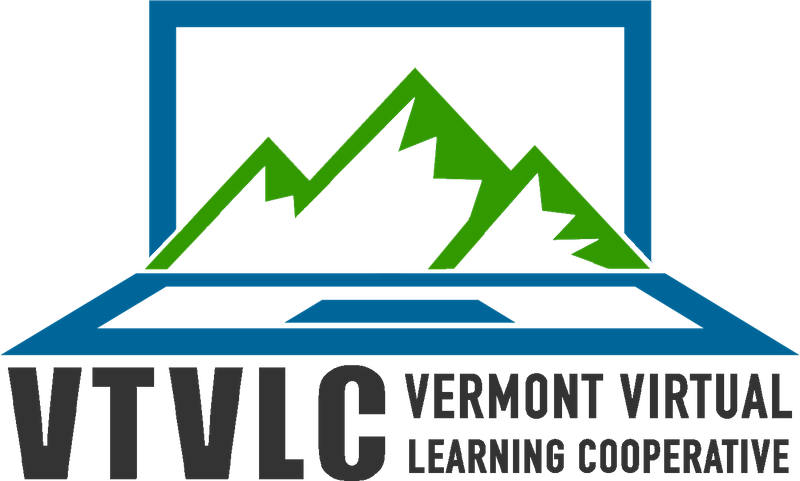What is Asynchronous Learning?
At the Vermont Virtual Learning Cooperative (VTVLC), one of the most popular questions we get is about asynchronous learning. While the term “asynchronous” may sound complex, it’s actually quite simple. In essence, asynchronous learning allows students to complete coursework on their own schedule, logging in to learn when it’s most convenient and effective for them.
Let’s take a closer look at what asynchronous learning means at VTVLC, how it works, and why it can be a powerful and engaging way to learn.

How Does Asynchronous Learning Work at VTVLC?
At VTVLC, students access their coursework through the Canvas Learning Management System (LMS). Once logged in, they can view assignments, readings, videos, discussions, and other materials for their course. Since learning isn’t bound to a specific class time, students can choose the time that best suits their schedules and learning preferences. Some students complete their coursework during a free period at school, while others work in the evening or on weekends—whatever works best for them!
This flexibility is one of the elements that makes asynchronous learning so appealing. Students aren’t constrained by a set class time, allowing them to balance their studies with other commitments, such as sports, extracurricular activities, or family responsibilities.
Traditional Fall/Spring Courses: Flexibility with Structure
While asynchronous learning offers flexibility, it doesn’t mean that courses are entirely self-paced. In our fall and spring courses, we coursework may be chunked into manageable sections, units, or modules with specific deadlines for assignments and assessments. This ensures that students stay on track and don’t feel overwhelmed by the entire course load at once.
Think of it this way: although students can choose when to complete their work within each chunk, the chunks have set deadlines. This structured approach combines the benefits of flexible timing with the accountability of deadlines, helping students maintain steady progress and avoid procrastination.
For example, if a course is divided into one-week sections, students may have several assignments due at the end of each week. They can complete this work whenever it’s most convenient for them within that timeframe, but the deadlines provide a structure to keep students engaged and on pace.
On-Demand Courses: Fully Flexible Pacing
For students looking for even more flexibility, VTVLC offers on-demand (or rolling enrollment) courses. These courses are designed to be completed within six months, so students can start anytime and work through the material at a pace that fits their personal schedule.
While this type of course doesn’t have specific deadlines, it’s helpful to set a personal schedule. For example, if a student wants to complete a 16-module course in 16 weeks, they should aim to finish one module each week. This can be a great way for students to develop time management skills and independence as they take ownership of setting and following a personal pace.
If students need help creating a plan, our student support team is available to help! We can work with students to set up a realistic schedule and provide guidance if adjustments are needed along the way.
K-8 Students: A Blend of Synchronous and Asynchronous Learning
In our K-8 program, students experience a blend of asynchronous and synchronous learning. While they have flexible, self-paced assignments to complete on their own, they also participate in live, virtual sessions with their teacher and classmates. This approach allows younger students to enjoy the benefits of asynchronous learning while also building a sense of classroom community, which can be so valuable in the early years.
Debunking Myths About Asynchronous Learning
There are often misconceptions about asynchronous learning, so let’s look at some of the most common myths and the truth behind them.
Myth #1: Asynchronous Learning Isn’t as Rigorous as Traditional Learning
Reality: Asynchronous learning at VTVLC is designed to be as rigorous as traditional, in-person classes. Our courses are structured to meet state standards and challenge students with in-depth content, critical thinking, and real-world applications. Students are held accountable through regular assessments, discussions, and project-based learning.
Myth #2: Asynchronous Learning Means Students Are on Their Own
Reality: At VTVLC, we provide extensive support for our students. Teachers are available to answer questions, give feedback, and meet with students virtually if needed. Additionally, our student support team can help students develop time management strategies, set goals, and adjust their plans if they need help keeping up with coursework.
Myth #3: Asynchronous Learning Isn’t Engaging
Reality: Asynchronous learning at VTVLC is designed to be interactive and engaging. Our courses incorporate multimedia elements—like videos, quizzes, and discussion boards—encouraging active participation. Students are also encouraged to engage in virtual discussions with peers, fostering a collaborative learning environment.
Why Asynchronous Learning?
Asynchronous learning offers many benefits that can help students succeed:
- Flexibility: Students can work around their own schedules, which can be particularly helpful for those juggling other commitments or personal preferences.
- Self-Paced Progress: Students can spend extra time on challenging concepts and move quickly through material they understand.
- Independence: Asynchronous learning encourages self-directed learning, which can build valuable skills for college and beyond.
- Customization: Students can choose the learning times that best align with when they feel the most focused and ready to learn.
Is Asynchronous Learning Right for You?
Choosing the right learning environment is essential to academic success, and asynchronous learning is a valuable option for many students. It offers flexibility, allows students to set their own pace, and encourages independence—all within a supportive structure.
At VTVLC, we’re here to make asynchronous learning as accessible, engaging, and rigorous as possible. If you have questions about our asynchronous programs or need help deciding if this approach is the right fit for your child, reach out to us! We’re happy to help you explore the opportunities asynchronous learning offers.
Asynchronous learning can be an exciting, empowering approach to education, and it’s here to stay. At VTVLC, we believe in providing students with the flexibility they need to succeed, no matter what their schedule or learning style may be.

